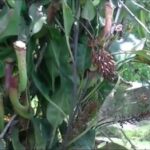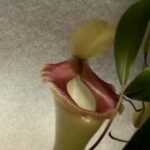As an Amazon Associate, this site earns commissions from qualifying purchases. For more details, click here.
Named after the famous naturalist David Attenborough, nepenthes attenboroughii is endemic to many parts of Southeast Asia. In the wild these pitcher plants grow up to 5 feet (1.5 m) with 12 inch (30 cm) wide pitchers. Those for home cultivation are much smaller but also easier to grow. While aimed at collectors, anyone can care for these plants.
Nepenthes attenboroughii prefers 70-80 F temperature with bright, indirect light. This pitcher plant grows fastest in 70-80% humidity with moist, low nutrient soil. This plant feeds on small bugs and even fish food.
Nepenthes Attenboroughii Care Sheet
| Soil | 1:1 peat and silica, moist soil |
| Water | Spring water, distilled, purified |
| Light | Bright, indirect light, 6-8 hours, grow lights may be used |
| Food | Fish food, bloodworms, mealworms, bugs |
| Temperature | 70-80 F (21-27 C) |
| Humidity | 70-80% |
| Dormancy | No |
| Propagation | Seedlings cutting |
Soil
Contrary to popular belief, growing n. attenboroughii is not that difficult. Many of its requirements are similar to other nepenthes and that includes soil.
Nepenthes attenboroughii thrives in poor soil such as silica sand and peat. You may also add a bit of live sphagnum on the top. Keep the soil moistened and that should be enough for the plant to grow.
The soil mix is usually 1:1 peat and silica, similar to what you would use with nepenthes alata. However you may also add clay granulate below the soil. Place the clay granulate (3-8 cm or 1 to 3 inches) into the pot and add peat and silica sand on top.
Peat and perlite should work with n. attenboroughii as well. In general the plant tolerates various soil mixes well provided they are low nutrient.
Pot Container
Wild n. attenboroughii are large enough to eat rodents and hold up to two liters of water. Fortunately, cultivated versions are much smaller, about 2 inches only.
A 3 to 4 inch pot is ideal for nepenthes attenboroughii. You can even grow this plant in a plastic cup. You can leave the pot on a windowsill or put it in a greenhouse. In fact the plant will look good in an HC Companies Planter Pot
Most n. attenboroughii are sold as seedlings and do not include a pot. That is not a problem since these plants are very small. If you want to be sure, contact the vendor and ask them how large it grows. Chances are it should fit nicely in a small container.
These pitcher plants are sturdy under the right growing conditions. Just like other nepenthes, they will benefit from repotting in spring just before any new growth comes up.
Water
Nepenthes attenboroughii requires purified water. Keep the soil moist and water from the top. Do not overwater the plant and do not fill its pitchers with liquid.
Most tropical pitcher plants like nepenthes x ventrata prefer overheard watering, and n. attenboroughii is the same. You should never let its soil go dry, but do not soak it in water because it will damage the roots.
There are a few simple rules to watering n. attenboroughii.
- Use only distilled or purified water. Reverse osmosis and rainwater are good too.
- Water all over the leaves and the soil. Do not let water gather on any particular leaf.
- Do not fill its pitchers with water. Healthy nepenthes pitchers contain liquids – including water- so no need to add any. Pouring a little bit does not actually harm the plant, but it brings little to no benefits.
- If the pitcher is empty, increase humidity around the plant. While it is recovering, you may add a bit of water into its pitchers
- Do not use tap water because it probably contains minerals that are dangerous to the plant. While some nepenthes can tolerate tap water, it is best avoided.
- Signs of lack of water are empty pitchers, dry leaves and discoloration.
- Signs of too much water are root rot, soggy soil and very damp leaves.
Light
Indirect, bright light is recommended for nepenthes attenboroughii. You can grow these pitcher plants on a bright window or a greenhouse.
Because light is so important for plants, you have to choose the right location and make sure they are getting enough. For nepenthes attenboroughii, the simplest way is to place it on a windowsill.
A south facing window provides partial light for plants, which is what you want. Because n. attenboroughii tolerates heat well, you can probably leave it by the window.
You take the same approach if you want to raise this nepenthes in a greenhouse or a CYS EXCEL Glass Terrarium. Position your plant so that it gets enough light without being directly under the sun.
As long as n. attenboroughii is not under scorching heat it will be fine. Remember to water the plant so the soil remains moist. Move the pot under shade if necessary.
Temperature
Nepenthes attenboroughii prefers 70-80 F / 21-27 C during the day and 55-60 F / 13-15 C at night. These pitcher plants can tolerate higher temperature for short periods.
The ideal scenario is bright, indirect light with the temperature range given above. Under these conditions you will get the best results. If your plant is indoors, you can easily check the temperature with a thermometer and ensure it is in optimum condition.
If it is too hot outdoors you can simply move the plant inside until the weather cools down. This is something you also have to consider if you are cultivating n. attenboroughii in a greenhouse. Make sure it does not get too hot and there is enough ventilation for the plant.
At night nepenthes attenboroughii prefers lower temperature in the low 60s to 55 F or so. The plant tolerates cold well but do not expose this to winter frost. As long as your nepenthes is in the given range- plus or minus a few degrees- it will thrive.
Humidity
The ideal humidity level for nepenthes attenboroughii is 70-80%. These pitcher plants can adapt to lower humidity, but you will get faster growth if the level is at least 70%.
If you have grown nepenthes before, one of the things you would have noticed is that most prefer high humidity. This is true for n. attenboroughii too especially in very warm weather.
Use a humidifier to increase the rate to 70% if necessary. Lack of humidity makes it difficult for nepenthes to produce liquids for its pitchers, so you have to keep an eye on it.
Nutrition and Feeding
Just to be clear, n. attenboroughii cannot eat humans. Even the large ones that grow in the wild, they do not. Though their pitchers are wide enough to put a human arm into, it prefers to eat insects just like other pitcher plants.
Nepenthes attenboroughii eats the same prey as other pitcher plants: gnats, yellow jackets, worms, crickets, flies, ants and other bugs. Wild n. attenboroughii occasionally eats rodents, lizards and larger prey that fall into their traps. This is not going to happen with their much smaller, cultivated counterparts.
Nepenthes should eat at least every two weeks. The larger the pitcher, the more food it can eat. Apart from bugs, these plants also consume fish food and freeze dried worms.
Outdoor pitcher plants do not require feeding as there is food available already. Their nectar attracts all kinds of insects, enough to keep the plant nourished. Only those incapable of catching bug need feeding.
Dormancy
Nepenthes attenboroughii is a tropical plant and does not go dormant. Most species remain active the entire year so no need to change its environment.
The essentials are the same for n. attenboroughii: high humidity, warm temperature, bright indirect light and water. Use only distilled or purified water so the soil does not dry up. As long as you maintain this – plus nutrition from bugs, worms or fish food – your nepenthes will grow strong and healthy.
If you live in a tropical climate, nepenthes will continue to grow. If you have winter, the plant might slow down even if you keep it indoors. The best thing you can do is maintain its environment – whether it is indoors or a terrarium– so the plant can flourish continuously.
Even under the best conditions, nepenthes attenboroughii grows slowly. But with patience you will be rewarded. Even if these plants do not reach the size of their counterparts in the wild, they are still impressive.

My fascination with carnivorous plants began many, many years ago with Venus Fly Traps. Now I am more than happy to impart what I know with other enthusiasts and those who are curious about meat eating plants.



